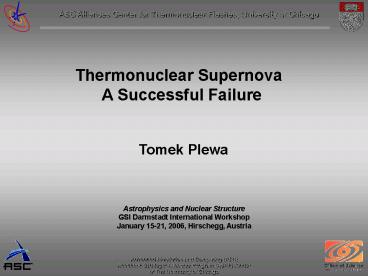Thermonuclear Supernova: A Successful Failure - PowerPoint PPT Presentation
1 / 32
Title:
Thermonuclear Supernova: A Successful Failure
Description:
ASC Alliances Center for Thermonuclear Flashes, University of Chicago ... Foreplay counts: forgotten tale of the ICs. Confronting DFD with observations. Summary ... – PowerPoint PPT presentation
Number of Views:46
Avg rating:3.0/5.0
Title: Thermonuclear Supernova: A Successful Failure
1
(No Transcript)
2
Outline
Introducing thermonuclear supernovae
Scales time, space physics
Many sins of turbulent deflagrations
Foreplay counts forgotten tale of the ICs
Detonating Failed Deflagrations
Confronting DFD with observations
Summary
3
What Are Supernovae?
4
Massive and Even More Massive
Type II Massive Single H-rich
Type Ia Medium mass Binary H/He-free
5
Type Ia SN Appearance
P. Nugent (LBNL)
6
Why Do We Care?
COBE
- SN Ia are crucial for galactic chemical
evolution. - SN Ia are also crucial for cosmology probes
allowing study of expansion and geometry (?M,
??) of the Universe, nature of dark energy - Provide astrophysical setting for basic
combustion problems.
High-Z Supernova Search Team, HST
7
40 Years of Theory
- 1960s
- WD explosion proposed for Type Ia (Hoyle
Fowler) - 1D detonation model (Arnett)
- 1970s
- detonation models (several groups)
- deflagration models (Nomoto)
- 1980s
- improved 1-D deflagration models (Nomoto)
- first 2-D deflagration model (Mueller Arnett)
- 1990s
- 2-D and 3-D deflagration models, DDT (Khokhlov)
- non-standard models 2-D He detonations (Livne
Arnett) - small scale flame turbulence (Niemeyer
Hillebrandt) - 2000s
- 3-D deflagration models (NRL, MPA, Barcelona,
Chicago)
8
Problem Parameters
- Channels for progenitors
- Binary evolution
- Population synthesis
- Initial conditions
- State of the stellar core
- Metallicity
- Rotation profile
- Magnetic fields
- Basic physics
- Flame on intermediate scales
- Unsteadiness
- DDT
- Numerics
- Multiphysics coupling
- Nucleosynthesis postprocessing
R. Hynes
INCITE 2004
F. Timmes
Zhang et al. (2006)
Khokhlov (2003)
9
Explosive Stage of SN Ia
102/4-7 cm
mild ignition
1010 seconds
deeply subsonic, Ma 10-4
10-3/5-8 cm
few seconds
deflagration
subsonic Ma 0.3
101/5-8 cm
detonation
0.5 second
compressible Ma 2
10
Why Large Scale Simulations?
Khokhlov (2003)
11
RT-driven Turbulence
Zhang et al. (2006)
12
Major Sins of Classic Central Deflagrations
1. Uniformly mixed ejecta, unburned low-velocity
carbon
2. Explosion energies too low, need 50 more
burning
3. Initial conditions either too idealized or
defined ad hoc
4. Large Ni-rich structures visible at maximum
light
5. Insufficient production of intermediate mass
elements
13
Central Ignition Whole Star Model
INCITE 2004
- Two models, 255,000 SUs and 5TB of data per
model, 8 km resolution
14
Ejecta Composition Pure Deflagrations
- Ni
C/O
- Si
- Mg
Gamezo et al. (2003)
Reinecke et al. (2002)
Roepke et al. (2005)
Garcia-Senz Bravo (2004)
15
Stratification, Energy Speculative DDT
- 3-D pure deflagration
- 3-D speculative DDT
Gamezo et al. (2003)
16
Initial Conditions
Garcia-Senz Woosley (1995)
Hoeflich Stein (2002)
Kuhlen, Woosley, Glatzmeier (2005)
17
Single Bubble, Three Different Methods
2-D
2-D
Livne, Asida, Hoeflich (2005)
3-D
Niemeyer, Hillebrandt, Woosley (1996)
and virtually the same result!
Calder et al. (2004)
18
Initial Conditions Location, Velocity Field
r1y100v100a3030in (inflowing, 100 km/s)
INCITE 2004
19
Initial Conditions Conclusion
Garcia-Senz Woosley (1995)
Hoeflich Stein (2002)
Woosley, Wunsch, Kuhlen (2004)
Calder et al. (2004)
Livne, Asida, Hoeflich (2005)
Kuehlen, Woosley, Glatzmeier (2005)
Based on analytic, semi-analytic, and numerical
models, the most likely outcome of a mild
ignition is the off-center deflagration.
20
Detonating Failed Deflagration
21
DFD Detonation Phase
22
Double-bubble DFD
23
Double-bubble DFD at 1 km resolution
24
Model Validation Radiative Transfer
Kasen, Thomas, Nugent (2006) Multi-dimensional
time-dependent Monte Carlo radiative transfer
25
Model Validation Radiative Transfer
Kasen, Thomas, Nugent (2006) Multi-dimensional
time-dependent Monte Carlo radiative transfer
26
Overall Spectrum Shape
DFD at 18 days vs. SN1981B at maximum light.
27
DFD/W7 At Maximum Light
28
Velocity Evolution
Orientation effects controlled by the
deflagration phase in the DFD model
Benetti et al. (2005)
29
Distribution of IME in DFD
30
GCD Spectral Signatures
Kasen Plewa (2005)
31
Tycho SNR Iron Distribution
FS
RS
???
Warren et al. (2005)
32
Summary
- Detonating Failed
Deflagration - displays several main characteristics of
observed objects - energetics, light curves, spectra/spectral
features - emphasized importance of the initial conditions
- detonation in unconfined environment
- natural chain of events, not by-hand, but from
first principles - Extremely rare case in theoretical
astrophysics!
To be continued!































